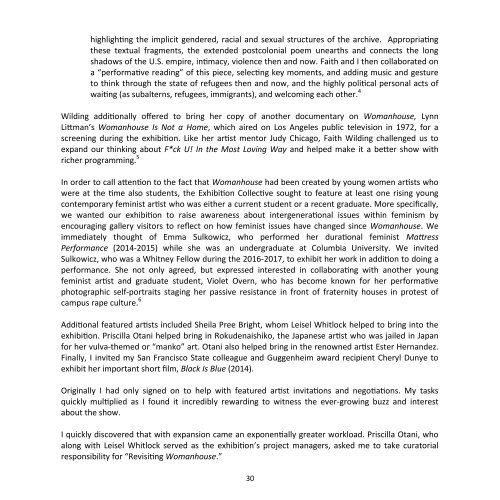F*CK U! In The Most Loving Way
Exhibition catalog for "F*CK U! In The Most Loving Way" created by the Northern California Women's Caucus for Art.
Exhibition catalog for "F*CK U! In The Most Loving Way" created by the Northern California Women's Caucus for Art.
You also want an ePaper? Increase the reach of your titles
YUMPU automatically turns print PDFs into web optimized ePapers that Google loves.
highlighting the implicit gendered, racial and sexual structures of the archive. Appropriating<br />
these textual fragments, the extended postcolonial poem unearths and connects the long<br />
shadows of the U.S. empire, intimacy, violence then and now. Faith and I then collaborated on<br />
a “performative reading” of this piece, selecting key moments, and adding music and gesture<br />
to think through the state of refugees then and now, and the highly political personal acts of<br />
waiting (as subalterns, refugees, immigrants), and welcoming each other. 4<br />
Wilding additionally offered to bring her copy of another documentary on Womanhouse, Lynn<br />
Littman’s Womanhouse Is Not a Home, which aired on Los Angeles public television in 1972, for a<br />
screening during the exhibition. Like her artist mentor Judy Chicago, Faith Wilding challenged us to<br />
expand our thinking about F*ck U! <strong>In</strong> the <strong>Most</strong> <strong>Loving</strong> <strong>Way</strong> and helped make it a better show with<br />
richer programming. 5<br />
<strong>In</strong> order to call attention to the fact that Womanhouse had been created by young women artists who<br />
were at the time also students, the Exhibition Collective sought to feature at least one rising young<br />
contemporary feminist artist who was either a current student or a recent graduate. More specifically,<br />
we wanted our exhibition to raise awareness about intergenerational issues within feminism by<br />
encouraging gallery visitors to reflect on how feminist issues have changed since Womanhouse. We<br />
immediately thought of Emma Sulkowicz, who performed her durational feminist Mattress<br />
Performance (2014-2015) while she was an undergraduate at Columbia University. We invited<br />
Sulkowicz, who was a Whitney Fellow during the 2016-2017, to exhibit her work in addition to doing a<br />
performance. She not only agreed, but expressed interested in collaborating with another young<br />
feminist artist and graduate student, Violet Overn, who has become known for her performative<br />
photographic self-portraits staging her passive resistance in front of fraternity houses in protest of<br />
campus rape culture. 6<br />
Additional featured artists included Sheila Pree Bright, whom Leisel Whitlock helped to bring into the<br />
exhibition. Priscilla Otani helped bring in Rokudenaishiko, the Japanese artist who was jailed in Japan<br />
for her vulva-themed or “manko” art. Otani also helped bring in the renowned artist Ester Hernandez.<br />
Finally, I invited my San Francisco State colleague and Guggenheim award recipient Cheryl Dunye to<br />
exhibit her important short film, Black Is Blue (2014).<br />
Originally I had only signed on to help with featured artist invitations and negotiations. My tasks<br />
quickly multiplied as I found it incredibly rewarding to witness the ever-growing buzz and interest<br />
about the show.<br />
I quickly discovered that with expansion came an exponentially greater workload. Priscilla Otani, who<br />
along with Leisel Whitlock served as the exhibition’s project managers, asked me to take curatorial<br />
responsibility for “Revisiting Womanhouse.”<br />
30


